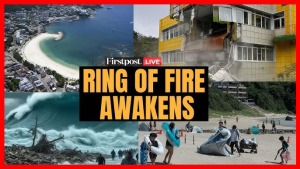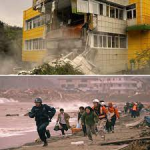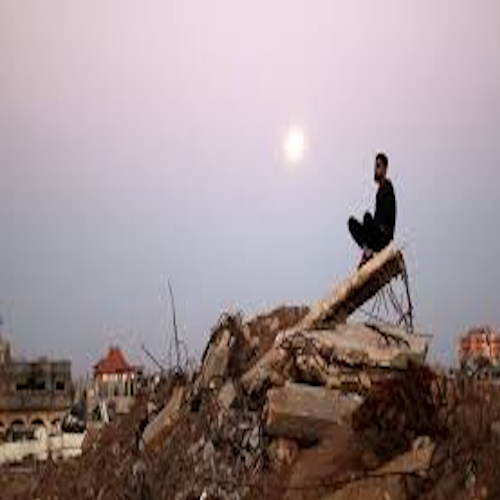1. Overview of the Event
On July 30, 2025, a monumental magnitude 8.8 earthquake shook the Kamchatka Peninsula off Russia’s Far East, becoming one of the largest seismic events recorded in modern history. The quake’s epicenter was located roughly 119–136 km east‑southeast of Petropavlovsk‑Kamchatsky, at a shallow depth of 19–20 km, accelerating concern over tsunami risk across the Pacific region.
The US Geological Survey (USGS) initially reported the quake as magnitude 8.0, later revised to 8.7–8.8; other agencies including GFZ and EMSC validated this depth and scale.
This was the strongest earthquake worldwide since the March 2011 Tōhoku event (Japan, M9.0), and the largest in Russia since major 20th‑century megathrust quakes .

2. Tectonic Setting: Why Kamchatka?
The quake occurred along the Kuril–Kamchatka subduction zone, where the Pacific Plate plunges beneath the Okhotsk microplate—a classic setting for megathrust earthquakes .
Previous historical quakes in the region include:
- 1952 Severo‑Kurilsk quake, magnitude ~9.0, generated 18 m tsunamis and caused over 2,300 deaths .
- 1737, 1841, 1923 events with magnitudes 8.5–9.3 and massive tsunami run‑ups .
- The 2013 Okhotsk Sea earthquake (M8.3) was deep (~609 km) and widely felt but caused minimal damage due to its depth .
The subduction zone accumulates stress over decades. Scientists had noted foreshocks in mid‑July (M7.4 on July 20 and a series of 6.x quakes), suggesting mounting tectonic strain ahead of the big rupture .
3. Sequence of Tremors and Aftershocks
- July 20: A magnitude 7.4 quake struck near Kamchatka (~10 km depth), followed by aftershocks; a tsunami warning was issued and later lifted .
- July 22: A magnitude 6.3 tremor occurred at 50 km depth, felt across the region .
- July 30: The main M8.8 quake struck; within about an hour, a M6.9 aftershock struck approximately 147 km from Petropavlovsk‑Kamchatsky at 10 km depth .
- Over twenty aftershocks of M ≥6.0 followed, reinforcing seismic risk in the aftermath .
4. Tsunami Impact & Warnings
Due to its shallow focus, the quake triggered large tsunami waves:
- Coastal regions of Kamchatka registered waves up to 3–4 meters .
- Warnings issued across Japan, Hawaii, Alaska, Guam, and parts of the US West Coast and Pacific islands .
- Japan recorded wave heights between 0.4 to 1.3 m, prompting evacuation of nearly 2 million people across more than 220 municipalities .
- Hawaii saw surges ~1.8–4 feet; Crescent City, California, sustained ≈$1 million in harbor damage, though infrastructure held better than during 2011.
Remarkably, despite the magnitude, the limited tsunami height and sparsely populated epicentral zone resulted in no confirmed deaths and only minor injuries in Russia .
5. Damage, Response & Heroic Moments
- Kamchatka’s towns, including Petropavlovsk‑Kamchatsky and Severo‑Kurilsk, suffered structural damage—fallen cabinets, shattered windows, building collapses, and power outages .
- In Severo‑Kurilsk, flooding from 3–4 m waves led to large‑scale evacuations and displacement of residents .
- In Petropavlovsk, a kindergarten façade collapsed, but no injuries were reported; minor injuries occurred at the airport, and some people were hurt while evacuating or jumping from windows .
- At Kamchatka’s oncology centre, surgeons continued operating mid‑quake, securing surgical tools and patient under tremor—praised as “heroes in white coats.” They are scheduled to receive state honors .
Local and global disaster response systems—including the Pacific Tsunami Warning Center (PTWC)—issued rapid alerts, enabling timely evacuations and minimizing casualties .
6. Why the Damage Was Limited
Despite rating among the top six strongest quakes on record, damage remained surprisingly low, thanks to several critical factors:
- Sparse population in the immediate coastal region greatly reduced exposure.
- Early alerts and coordinated evacuations across Russia and Pacific nations averted mass tragedy .
- Moderate tsunami wave heights (max ~4 m) versus catastrophic levels seen in historical quakes.
- Countries in the Pacific had improved warning infrastructure and public awareness, stemming from lessons learned in 2004 and 2011.
Still, analysts warn that the global warning system requires continued funding and upgrades—especially for underserved regions like the Atlantic basin.
7. Historical Context
This earthquake echoes past megathrust events in Kamchatka history:
| Year | Magnitude | Notes |
|---|---|---|
| 1737 | ~9.0–9.3 | Generated 60 m tsunamis, possibly largest known run-up in peninsula history . |
| 1841 | ~9.0 | Tsunami up to 15 m, intensity VIII–IX . |
| 1952 | ~9.0 | Severo‑Kurilsk devastated; ~2,336 confirmed fatalities . |
| 1923 | 8.5 | Another heavy rupture along trench . |
| 2013 | 8.3 | Deep quake felt far afield, minimal impact . |
The 2025 event reinforces that large stress accumulation over decades can yield periodic megathrust ruptures along major convergent zones.
8. Scientific Significance & Lessons Learned
- Foreshock detection (e.g. M7.4 on July 20) underscores value of close monitoring and early signals in seismic forecasting .
- The role of disaster coordination centres like PTWC, USGS, EMSC, Russian Emergencies Ministry, and Japan’s Meteorological Agency proved crucial .
- The success of mass evacuations, affecting millions, emphasizes how global cooperation can reduce casualties even during record‑breaking seismic events.
- The event raises urgency to fund tsunami‑early warning systems globally, as highlighted by experts who worry about gaps in Atlantic coverage .
9. Economic & Strategic Impact
- Severe damage was limited, but critical infrastructure—like the naval base at Rybachiy, housing Russia’s Pacific Fleet—suffered pier damage, potentially impacting docking submarines and warships .
- Harbor disruption in Crescent City, California, signaled financial vulnerability even far from epicenter; California’s infrastructure has improved since 2011, limiting losses to ~$1 million .
- Global shipping routes, Pacific trade lanes, and emergency preparedness logistics are under review in light of this quake’s far‑reaching alerts and minor but notable impacts abroad.
10. Outlook: What Comes Next
- Aftershock monitoring continues: dozens of M6+ aftershocks reinforce risk of further seismic movement.
- Scientists will focus on studies of rupture dynamics, stress transfer, and tsunami generation potential along the trench.
- Emergency agencies globally will analyze protocol performance and identify weak points, especially in public messaging, evacuation clarity, and low‑income coastal regions.
- Long term: increased funding support for tsunami‑resilience systems, seismic sensors, public drills, and cross‑national coordination.
Conclusion
The July 30, 2025 Kamchatka earthquake, often dubbed the “Earthquack in Russia”, stands among history’s most powerful seismic events—yet reflects a triumph of early warning, coordinated evacuation, and community readiness. While the magnitude‑8.8 tremor triggered a notable tsunami and caused structural damage, especially in Severo‑Kurilsk and Petropavlovsk‑Kamchatsky, there were no confirmed deaths—a stark contrast to similar quakes in 1952 or Japan 2011. The event underscores persistent seismic risk in the Pacific Ring of Fire, especially along the Kuril–Kamchatka trench, and reinforces the need for global tsunami warning expansion, continuous monitoring of seismic swarms and foreshocks, and investment in preparedness infrastructure.












